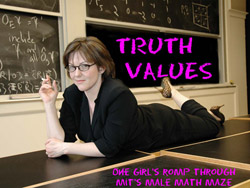Alumna's One-Woman Show Looks at Studying Math at MIT
-
-
slice.mit.edu
- 1
Filed Under
Recommended

These days, performance artist and writer Gioia De Cari SM ’88 calls herself a "recovering mathematician." Back in the late ’80s, she was pursuing a PhD in math at MIT but stopped after receiving her master's. Why? That's the subject of her autobiographical one-woman show, "Truth Values: One Girl's Romp through MIT's Male Math Maze." The play, which was named an outstanding solo show at the New York International Fringe Festival in August, runs Sept. 10-20 at the Central Square Theater in Cambridge.
In the production, De Cari performs more than 30 characters, impersonating students, professors, staff, and other intellectuals as she explores the role of women in science. The result is both humorous and thought provoking. She talks about her allure with nerds, being asked to serve cookies at a seminar, and retaliating with fashion experiments, all the while asking the questions: How has academia changed over the past 20 years? and What does equality and diversity in education really mean?
Select shows will offer post-performance discussions about gender equality with professors and scientists from MIT, Harvard, and other area schools, including MIT Professor of Biology Nancy Hopkins, MIT's Mathematics Department Head Michael Sipser, and MIT Professor of Physics Janet Conrad.
De Cari worked on the play for many years, always setting it aside. "There came a point, though, when it seemed to me that the whole women in science issue was so passé that I felt embarrassed to talk about my experiences," she says in an interview on the Central Square Theater's blog. "I was hearing about MIT, especially, being on the forefront of addressing these problems. Then as you may remember, Lawrence Summers made this outrageous remark about women perhaps being inherently inferior to men in math and science, and at that point I figured it was my duty as an artist and a woman…to speak up."
These days at MIT, undergraduate enrollment of women is approaching half. In fall 2008, 45 percent of students were female. That same year, 31 percent of all grad students were women. In fall 2007, 22 percent of math grad students were women. In 2006, MIT President Susan Hockfield created a new senior leadership position, associate provost for faculty equity, to focus on issues including the recruitment, retention, promotion, and career development of minority and women faculty. Professors Wesley Harris and Barbara Liskov share the appointment. To learn more about diversity initiatives at MIT, read President Hockfield's 2009 MLK Jr. Day celebration address, "Building a Culture of Inclusion through Distributed Leadership."
And alumnae—connect with other MIT women by joining the Association of MIT Alumnae (AMITA).








Comments
India Starker
Thu, 09/10/2009 12:02pm
I would love to go to this. And that picture is gorgeous.
Also, if it is true what Summers said in 2005, "fewer girls than boys have top scores on science and math tests in late high school years" I don't see how that reflects at all on girls like us that have top scores -- except to say that we are more rare than the boys who have top scores.